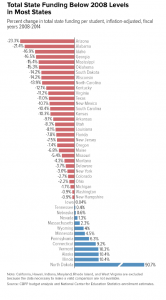Since the Recession most states have cut back on K-12 funding: what does this mean for our children?
Nation’s charter schools aren’t growing as fast as once thought, but here’s where they’re growing fastest-
February 23, 2016Across the country, school districts are quietly arming teachers for the next shooting – Good or Bad?
May 16, 2016Since the Recession most states have cut back on K-12 funding: what does this mean for our children?
A report published by the Center on Budget and Policy Priorities, a nonprofit research and policy institute, states:
• At least 31 states provided less state funding per student in the 2014 school year (that is, the school year ending in 2014) than in the 2008 school year, before the recession took hold. In at least 15 states, the cuts exceeded 10 percent.
• In at least 18 states, local government funding per student fell over the same period. In at least 27 states, local funding rose, but those increases rarely made up for cuts in state support. Total local funding nationally ― for the states where comparable data exist ― declined between 2008 and 2014, adding to the damage from state funding cuts.
• While data on total school funding in the current school year (2016) is not available, at least 25 states are still providing less “general” or “formula” funding ― the primary form of state funding for schools ― per student than in 2008. In seven states, the cuts exceed 10 percent.
• Most states raised “general” funding per student slightly this year, but 12 states imposed new cuts, even as the national economy continues to improve. Some of these states, including Oklahoma, Arizona and Wisconsin, already were among the deepest-cutting states since the recession hit. More alarming is the report says some states continue to cut funding even after the economy has started to rebound.
Here’s a state-by-state chart:
https://img.washingtonpost.com/blogs/answer-sheet/files/2015/12/chart1.png
Among the consequences of K-12 state-level spending are, the report says:
• Weakening a key funding source for school districts. About 46 percent of K-12 spending nationally comes from state funds (the share varies by state). Cuts at the state level force local school districts to scale back educational services, raise more local revenue to cover the gap, or both. And because property values fell sharply after the recession hit, it has been particularly difficult for local school districts to raise significant additional revenue through local property taxes without raising tax rates, a politically challenging task even in good times.
• Slowing the economy’s recovery from the recession. School districts began cutting teachers and other employees in mid-2008 when the first round of budget cuts took effect, federal employment data show. By mid-2012, local school districts had cut 351,000 jobs. Since then, they have restored some of the jobs but are still down 297,000 jobs compared with 2008. These job losses reduced the purchasing power of workers’ families, weakening overall economic consumption and, thus, slowing the recovery.
• Impeding reforms widely acknowledged to boost student achievement. Many states and school districts have identified as a priority reforms that would better prepare children for the future, such as improving teacher quality, reducing class sizes and increasing student learning time. Deep funding cuts hamper their ability to implement many of these reforms. For example, while the number of public K-12 teachers and other school workers has fallen by 297,000 since 2008, the number of students has risen by about 804,000. At a time when producing workers with high-level technical and analytical skills is increasingly important to a country’s prosperity, large cuts in funding for basic education could cause lasting harm.
I wonder, if we are sacrificing reforms, cutting key funding and eliminating teacher jobs, what’s happening to security at our kid’s schools? Is this being overlooked as well?
Photo by hywards at freedigitalphotos.net



